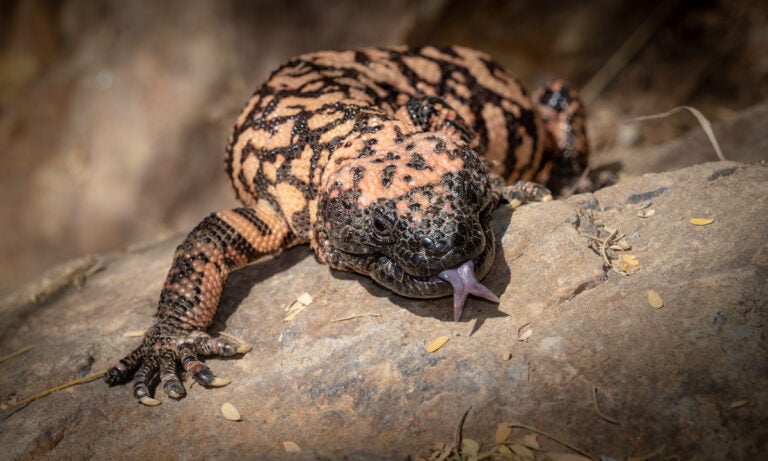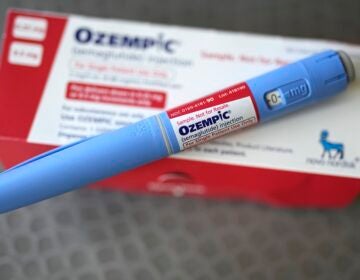How experiments with gila monster venom led to blockbuster weight loss drugs like Ozempic
Elon Musk wants to cut funding for scientific research, but the weight loss drugs he promoted also came from government funded basic science.
Listen 8:48
The Gila monster is a venomous lizard found in the Southwestern U.S. and northwestern Mexico’s Sonora. (Bigstock/Jay Pierstorff)
This story is from The Pulse, a weekly health and science podcast.
Find it on Apple Podcasts, Spotify, or wherever you get your podcasts.
Billionaire Elon Musk suddenly has the power to cut large swaths of U.S. government funding, and one of his many targets is scientific research.
Last year, one person tweeted that the U.S. government paid for an experiment that tested bobcat urine on rats, and Musk responded, “some of this stuff is not merely a waste of money, but outright evil.”
However, Musk has also publicly supported using weight loss drugs in the same category as Ozempic, and tweeted that “Nothing would do more to improve the health, lifespan and quality of life for Americans than making GLP inhibitors super low cost to the public. Nothing else is even close.”
The very same class of medications, GLP-1 agonists, that he promoted comes from government funded science that started in the 1980s with curious scientists testing a variety of venoms on guinea pig pancreases. . Science that researchers say would likely not be funded today.
Back in the summer of 1980, gastroenterologist Jean-Pierre Raufman started working at the National Institutes of Health. The research was not especially glamorous. His job was to take guinea pig pancreases and test them with venom from animals like bees, wasps, snakes, frogs, and lizards.
This was part of research on the digestive system. The pancreas plays an important role because it produces enzymes that help us digest food. The researcher Raufman worked under wanted to know if there was anything in venom that would trigger the pancreas to release more enzymes and digest food more quickly.
“It can be quite tedious,” Raufman said. Every day for weeks, he would dissolve powdered venom into water, add it to test tubes with bits of guinea pig pancreas, and see what happened.
“The hope is that in the end .. you discover something interesting. And it’s even more tedious if the experiment fails. You can do all of that and end up with nothing,” Raufman said.
After weeks of this work, he found that the venom that triggered the biggest reaction came from the gila monster, a large orange and black lizard from the southwestern U.S. It can grow up to 22 inches and hunts with powerful jaws. It’s one of the rare lizards that has venom.
Raufman and his colleagues published their findings and talked about it at conferences.
“It was seemingly an interesting biological finding … would never have conceived that there was any potential therapeutic benefit for anything,” he said. “To my recollection. I never tested it in human cells.”
He continued his work with another researcher in New York, where they figured out the specific protein of the venom that triggered the pancreas. They found that this protein works like a hormone called GLP-1, which humans have, and which triggers the pancreas to release insulin.
Endocrinologist Daniel Drucker at the University of Toronto heard about this discovery, because he was already interested in GLP-1, but did not understand why the gila monster would have something like that in its saliva.
“Right away, there was a realization that something that stimulates insulin secretion could be used for the treatment of diabetes.”
Subscribe to The Pulse
He said scientists at the time were trying to make a human diabetes treatment based on GLP-1, but it was difficult because humans would break down the hormone, or would get sick if they got too much of it too quickly.
So once he heard about Raufman’s discovery, he shipped a live gila monster to Canada, then studied its venom and the genes behind the protein that works like GLP-1.
Other researchers continued working on GLP-1 in humans in the 1990s and 2000s. Finally, in 2005, the U.S. Food and Drug Administration approved a GLP-1 therapy for diabetes, which later led to the blockbuster drug now known as Ozempic.
“We didn’t know that GLP-1 would reduce appetite and be useful for weight loss,” Drucker said. “We didn’t know that GLP-1 would reduce heart attacks and strokes and improve metabolic liver disease and all of the things that GLP-1 does now.”
Today, millions of people have prescriptions for GLP-1 medications like Ozempic. But to get to this point, it took a lot of basic science, which is focused on learning about the world.
“We would often do experiments in animals and say, ‘hey, this would work,’ … and then the pharmaceutical or biotech companies would say,’ well, let’s try and develop drugs based on these findings,'” Drucker said.
Raufman, who is now the chair of the gastroenterology department at the University of Maryland, said he is not sure if the National Institutes of Health would fund research like that today, because they now set a high bar for researchers to show that the work will likely help treat human disease.
“This would be considered by NIH study sections and others as sort of a fishing expedition,” he said. “If you were a betting person, you’d probably bet that we’d end up with nothing.”
“It’s very rare, frankly, that something goes this way and that frequently it’s a combination of luck, some intelligence, some foresight into doing the right experiments,” Raufman said. “Nobody knew where it would lead, and several of the participants are unfortunately now deceased. So (they) really haven’t seen what’s happened with this.”
WHYY is your source for fact-based, in-depth journalism and information. As a nonprofit organization, we rely on financial support from readers like you. Please give today.







